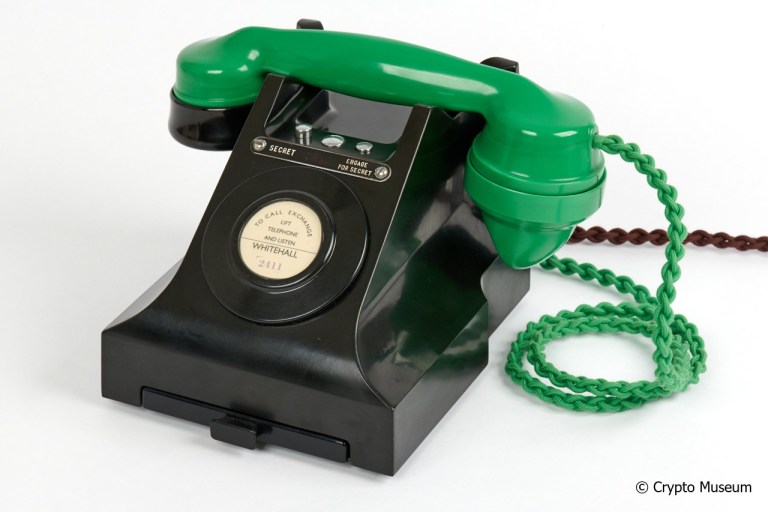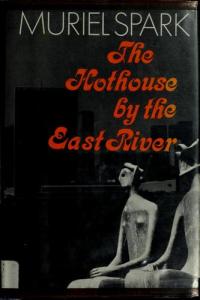“Jangling caterwauls”: Muriel Spark and the scrambler telephone
Beatriz Lopez explores Spark’s wartime use of a secure telephone and considers the device’s later disturbing reappearance in her novel The Hothouse by the East River (1973)

Successful wartime propaganda depended on a constant supply of reliable and up-to-date intelligence, information which – to guarantee security – British propagandists often received via a scrambler telephone. The Political Warfare Executive (PWE) most likely used a Secraphone or A-3 Scrambler (above), a green painted telephone which used ‘Frequency Domain Scrambling’ – a technique which inverted the frequency of telephone signals – in order to conceal the speakers’ voices.[1] The PWE’s black propaganda supremo Sefton Delmer trusted the scrambler to allow conversation ‘in complete confidence of secrecy, knowing that anyone trying to listen in would hear nothing but a meaningless jumble.’[2] Listen to the scrambler telephone here:
However, the instrument relied on outdated technology and could not guarantee secure speech. Unaware to the Allies, the Germans had already managed ‘to eavesdrop on A-3 using a site on the Dutch coast, and by 1940 had begun to intercept calls between Roosevelt and Churchill that used this system.’[3] Simultaneously, the mathematician and computer scientist Alan Turing was collaborating with Bell Telephone Laboratories to create Sigsaly, the first digitally-encrypted scrambler; unfortunately Sigsaly was only made available to high command, and most government officials continued using Secraphones or A-3 Scramblers during and after the war.[4]

Muriel Spark worked as a Duty Secretary for the PWE from May to October 1944, a role which required use of the scrambler. In her memoir Curriculum Vitae (1992), she describes how its ‘continual jangling noise made interception difficult’, forcing one ‘to listen “through” the jangle.’[5] Spark operated the scrambler to collect nightly information from returning Allied bombers – ‘the details of the bombing, the number of planes that had gone out and those (not always all) that had returned’ – which she would then pass on to her boss Sefton Delmer. Aided by photographs, maps and local knowledge, Delmer’s team would use this information to build a realistic reconstruction of damage, which could then be used to fabricate plausible stories.
Spark was also in charge of picking up another nightly call from the newsroom of the Foreign Office, which provided ‘general news not yet released for the next day’s newspapers’.[7] While the armed forces call remained businesslike, the Foreign Office call ‘would often lapse into the personal’ and soon led to Spark’s friendship with her interlocutor, Colin Methven. Spark’s PWE work arguably triggered what she described as her ‘addiction to the telephone’, and representations of this medium would subsequently loom large in her novels.[8]
While Spark’s fictional treatment of media technologies reflects the modernist preoccupation with the relationship between individuals and machines, representations of the telephone in her fiction are also historically contingent, pointing to anxieties about secure speech and electronic surveillance emerging from Second World War intelligence, Cold War surveillance and the Watergate scandal (1972-4).[9]
Unlike modernist fiction, which ‘highlighted the malfunction of telephone as medium’, Spark’s ‘scrambler novels’ of the 1970s draw attention to the ways in which ‘the human factor’ hinders direct voice communication.[10] The Hothouse by the East River (1973), for example, presents telephone scrambling as an intelligible activity deployed to satirise the illusory nature of her characters’ hold on reality.

The Hothouse by the East River is the novel which most closely depicts Spark’s work for the PWE. Its central character Elsa works alongside her husband Paul for a secret propaganda organisation during the Second World War; like Spark, Elsa is tasked with transcribing military intelligence, using ‘a special green telephone […] whose connection [was] heavily jammed with jangling caterwauls to protect the conversation against eavesdropping’.[11]
The novel moves between realistic sections describing the couple’s wartime experiences in England and hallucinatory passages describing their ghostly and unreal lives in post-war New York. Elsa, whose shadow points in the wrong direction, is described as a cunning schizophrenic, whose thinking and behaviour must be policed by her husband and her psychiatrist Garven.
In a twist towards the end of the novel, however, we learn that Paul and Elsa both died during an air raid in 1944, and that their children therefore never existed. Paul’s attempts to negate such a reality have led to their present purgatorial nightmare, which Elsa continuously attempts to disrupt – aided and abetted by a telephone. On the phone to his son Pierre, for example,
Paul’s attention is meanwhile eared to the voice at the other end and his free hand stretches forth with a helpless flutter to hush Elsa’s talk, like the hand of that King Canute who forbade the sea to advance in order merely to illustrate the futility of the attempt. “I can’t hear what you say,” says Paul into the mouthpiece. “Your mother’s talking.”[12]
Elsa here conforms to Avital Ronell’s characterization of the schizophrenic as a scrambled telephone line, which allows her to escape from ‘the puerile, reactionary dragnet of psychiatric wisdom’ through ‘structures of disconnection’.[13] By scrambling Paul’s conversation to his imaginary son, Elsa’s voice severs Paul’s fatherhood and forces him to confront the delusory nature of their New York existence. Her seemingly unintelligible speech, rendered as scrambler noise, exposes the artifactual nature of Paul’s myth-making and gives a voice to Elsa’s previously silenced perspective.
The Hothouse by the East River depicts scrambling as a call for reality in a hallucinatory world, which allows the expression of Elsa’s previously suppressed perspective. While the PWE used telephone scrambling as passive noise to support the secure communication of information, Spark adopts it as a fictional method with radical potential for inverting power relations and challenging the status quo in tightly controlled environments.
Beatriz Lopez discusses Spark’s use of the scrambler telephone further at the Crossed Lines Telepoetics symposium (27 May 2020) – register for online attendance and listen to a podcast of her talk here
Thanks to the Crypto Museum for permission to reproduce the image and sound of the scrambler telephone.
Notes
[1] Sheila Mair, ‘Scrambled Phones’, Science Museum Blog, 8th December 2019. https://blog.sciencemuseum.org.uk/scrambled-phones/ (accessed 18/05/2020).
[2] Sefton Delmer, Black Boomerang: An Autobiography: Volume Two (London: Secker & Warburg, 1962), 81.
[3] Robert Aldrich, ‘Whitehall Wiring: The Communications-Electronics Security Group and the Struggle for Secure Speech’, Public Policy and Administration 28.2 (2012): 178–95, 185.
[4] Aldrich, ‘Whitehall Wiring’, 185-6.
[5] Muriel Spark, Curriculum Vitae: A Volume of Autobiography (Manchester: Carcanet, 2009), 152.
[6] Martin Stannard, Muriel Spark: The Biography (London: Weidenfeld & Nicolson, 2009), 65.
[7] Spark, Curriculum Vitae, 153.
[8] Spark, Curriculum Vitae, 163.
[9] Amy Woodbury Tease, ‘Call and Answer: Muriel Spark and Media Culture’, Modern Fiction Studies 62.1 (2016): 70-91, 72.
[10] David Trotter, Literature in the First Media Age: Britain between the Wars (Cambridge, MA: Harvard University Press, 2013), 46.
[11] Spark, The Hothouse by the East River (Edinburgh: Polygon, 2018), 50.
[12] Spark, The Hothouse, 46.
[13] Avital Ronnell, The Telephone Book: Technology, Schizophrenia, Electric Speech (Lincoln: University of Nebraska Press, 1989), 110.
